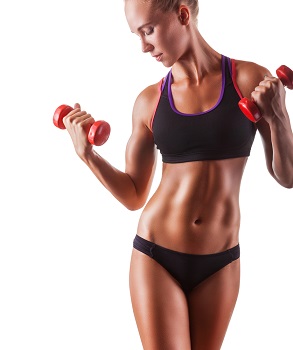Your volleyball workouts should consist of specific exercises for training the core.
Volleyball Core Training
Think of training movements not just muscles.
Volleyball Workouts and Jump Training
Working the kinetic chain
Your body parts act as a system of chain links, whereby the energy or force generated by one link (or part of the body) can be transferred successively to the next link.
When you are training, the focus should be on strengthening your muscles while activating this kinetic chain. We want integration of the whole kinetic chain not muscles in isolation.
For example, when you train your leg muscles, you don’t just focus on the movement of your legs. Machine leg curls or leg lifts focus on using your legs in isolation. Exercises such as squats and lunges focus on working leg muscles in conjunction with the muscles around your hips, knees, ankles, and back. Exercises that involve variations of the squat are great because they activate your core. Your core must be activate in order to perform squats correctly. So you could basically say that squats are good because they force you to work your core muscles.

Volleyball Workouts
Strength train while focusing on ground-based movements
Just like most sports, movements in volleyball occur with your feet in contact with the ground (ground based).
In volleyball, you create movement by force that you exert into the ground. How effective you are at using ground reaction force has a major influence on your performance on the court.
The most common strength training exercises for improving leg strength involve squat variations.
You want to fire the right muscles at the right time.
You don’t spike a volleyball with just your arm. How effectively you spike will have a great deal to do with how strong your core is.
The limbs of tree will break if the trunk is too weak to handle them. In the same way, if your core needs to be strong in order to perform explosive powerful movements with your arms.
So it’s very important to strengthen your arms while activating your core. Always activating your core while you train will improve your core strength thus allowing you to improve strength and power. Don’t let your lack of core strength be your limiting factor.
You want to have the ability to recruit muscles in proper sequence.
For example, when you approach to jump, force is created from the ground up.
Jumping is basically referred to as the triple extension of the hip, knee, and ankle.
Exercises that train the triple extension movement will improve a volleyball players ability to use the ground effectively.
Remember, you want to train the body as a whole system rather than training the body in isolated parts.
Highschool Team Volleyball Workouts
Movement starts at the core.
It’s important to realize your core muscles are your body’s engine and most movements initiate from there.
You want to improve your balance, agility, speed, timing, endurance, and power. And having a strong core is essential to accomplish this.
Your core transfers force from the lower to upper body and vice versa.
A weak core will lead to inefficient movement and greater risk for injury.
Balance and Proprioception are important concepts.
Two training concepts that are often overlooked in volleyball strength programs are balance and proprioception.
These concepts are vital because they underline all movement.
When training for volleyball, your balance and proprioception needs to be constantly challenged.
Unilateral volleyball workouts are very important.
Use unilateral movements when you train. Unilateral involves single arm, single leg movements. This is different than bilateral. Unilateral helps improve balance and creates a well rounded strong athlete. Unilateral strength can be a precursor to injury.
Core training is very challenging and a lot of hard work. It can also be a lot of fun. The results you get are well worth the effort.
Home › Weight Training › Workouts
